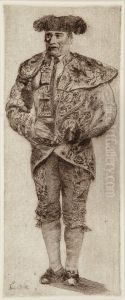Rafael Esteve Paintings
Rafael Esteve Vilella was a Spanish engraver, born in Valencia in 1772. Esteve was best known for his mastery in the art of engraving, particularly within the neoclassical style that was prevalent during his time. Esteve's artistic journey began under the tutelage of his father, who was also an engraver. His talent became evident early on, and as a young man, he furthered his artistic education by studying at the Real Academia de Bellas Artes de San Carlos in his hometown.
Esteve's work gained recognition for its technical precision and clarity, which led him to receive commissions from important institutions and figures of his era. In 1804, he moved to Madrid, where he was appointed as an engraver to the court of King Charles IV of Spain. This role allowed him to work on a variety of significant projects, including the creation of engravings based on paintings by renowned artists such as Diego Velázquez, which contributed to the diffusion of Spanish fine arts.
One of Esteve’s notable contributions was his work on the series of engravings titled 'La Tauromaquia' ('The Art of Bullfighting'), which depicted various aspects of bullfighting. The series, which was based on paintings by the famous Spanish artist Francisco de Goya, is considered one of his masterpieces and reflects Esteve's skill in translating the dynamism and energy of Goya's paintings into the medium of engraving.
Throughout his career, Rafael Esteve remained active in the artistic community, contributing to the spread of neoclassical aesthetics in Spain. His engravings were not only important for their artistic value but also as historical documents that captured the cultural and societal interests of his time. Esteve's legacy is preserved in the collections of various museums and institutions, where his engravings continue to be studied and admired for their beauty and technical proficiency. He passed away in 1847, leaving behind a body of work that remains influential in the history of Spanish art.
